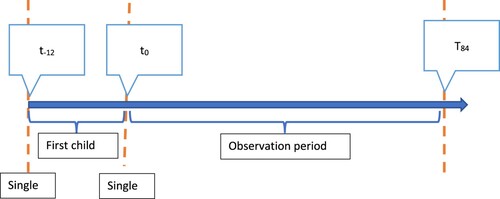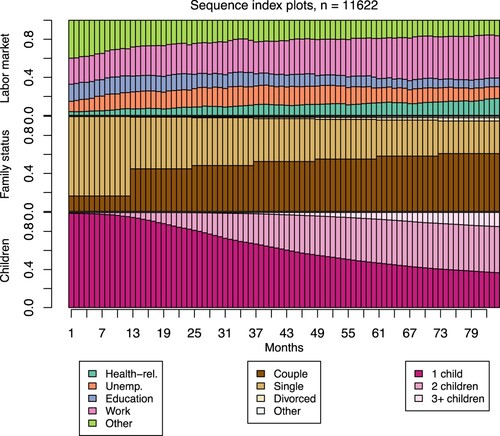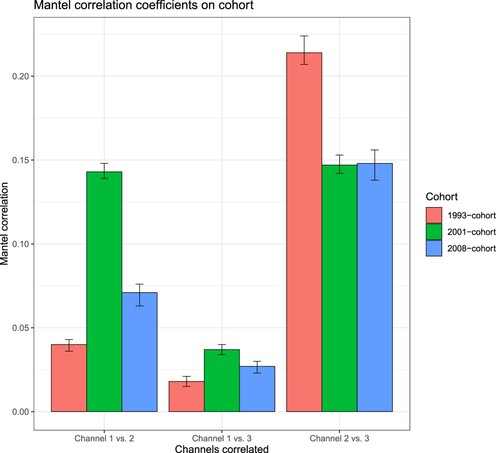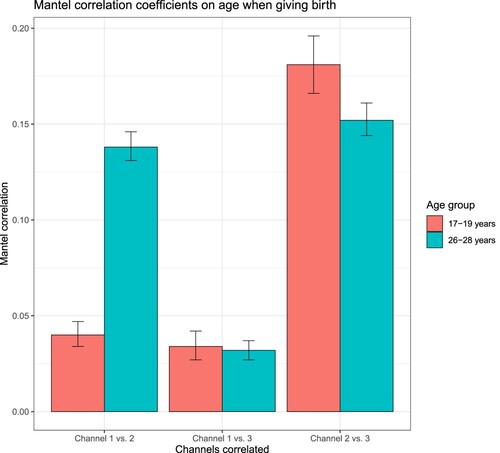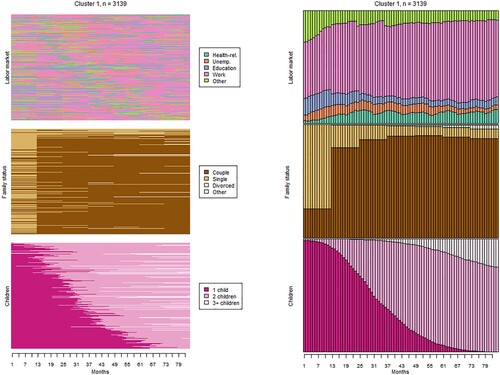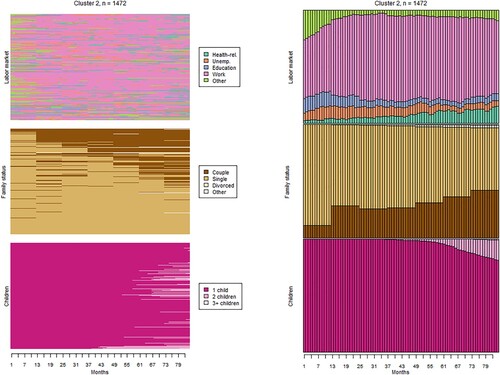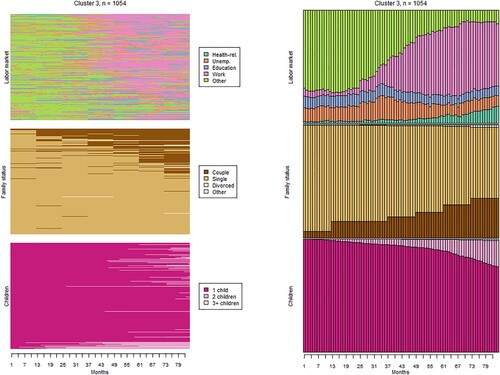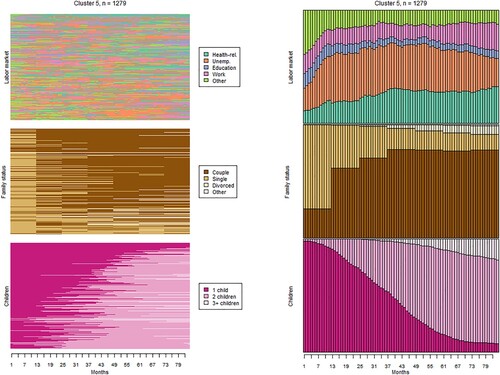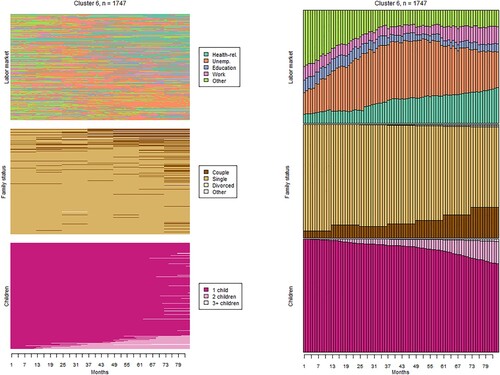ABSTRACT
In this article, we use population-based administrative data and multichannel sequence analysis to investigate the trajectories of single mothers in Norway who had a child while unpartnered in 1993, 2001 and 2008. Our observation period is from 1994 to 2015. This period covers several structural transformations in Norwegian society and changes in family policies and welfare policies concerning single mothers. Furthermore, the period saw the growth of alternatives to the nuclear family as the prevailing normative ideal. Our findings demonstrate both complexity and heterogeneity among single mothers and their trajectories. Even so, the population of this group of single mothers is both younger and have lower education than the comparable population of non-single mothers. Nearly half of the single mothers followed trajectories characterized by strong labour market integration and family re-establishment. The other half followed more precarious trajectories characterized by unemployment and health related benefits. Importantly, age and life stage have strong implications for the labour market and family trajectories. Thus, early parenthood combined with leaving school early increases the probability of following precarious trajectories. The results further suggest that both economic cycles and changing welfare state framework is of great importance for single mother trajectories.
Introduction
Having a child without living with a partner has historically been a vulnerable and stigmatized position. The status of single motherhoodFootnote1 was connected to immoral behaviour, low social status, insufficient housing, poverty, or lack of education and represented as deviancy and a social problem long into the twentieth century (Duncan & Edvards, Citation1999; Kiernan et al., Citation1998; Øyen, Citation1966). Today, most people in Scandinavia no longer consider single motherhood to be a break with moral norms, and it may even be chosen by women who want a child, using fertility technology. However, we have little knowledge of the impact of this event on life trajectories today.
The increasing numbers of unpartnered women who have a child represent one of the major demographic changes in Western countries since the 1970s (Bernardi et al., Citation2018). However, this umbrella category is becoming increasingly difficult to define, because of the greater diversity of intimate relationships, and in particular the complexity of residential arrangements between parents and children (Bernardi et al., Citation2018; Skevik, Citation2006a). We focus on unpartnered women who give birth. Our primary motivation is related to the vulnerability of this group of single mothers. Previous research has found that single mothers who were neither married nor cohabiting before childbirth represent a separate profile of single motherhood from that of divorced or separated mothers (Letablier & Wall, Citation2018). They are younger, have lower education levels and have younger children (Kjeldstad, Citation1998; Letablier & Wall, Citation2018). Such single mothers may therefore be affected by welfare policy in different ways from those who assume that status after a divorce/break in a cohabitating relationship. They are also potentially more vulnerable to changes in the economy and welfare policy, as they may be less established in the labour market. The Norwegian case is interesting because the country had a major policy change, restricting the rights of single parents in the late 1990s.
The dynamic character of single parenthood has long been established in the research literature (Bernardi et al., Citation2018; Kiernan et al., Citation1998; Lewis, Citation1997). The period as a single parent varies in duration and may come to an end by getting a partner or by the children becoming adults. In our study we will use Norwegian administrative data and sequence analysis to explore how a life transition as becoming a mother unpartnered is followed by different trajectories in the spheres of family, work and welfare benefits. To our knowledge, this has not been done before and gives us the unique possibility to shed light on the heterogeneity of unpartnered mothers who had a child in the study period. By using sequence analysis, we can explore how events as family establishment, work, welfare benefits and education interact in a life course perspective. We ask, what were the most common labour market and family trajectories of single mothers? Do they differ between the three cohorts of 1993, 2001 and 2008, and can potential differences be related to changes in the labour market, welfare policy, and/or the composition of the group? Furthermore, what kind of interdependencies exist between the life-course domains of the labour market and family life? How do work and family life interact and constrain one another? More precisely, we ask how interdependencies change between cohorts, and whether the age when women become single mothers influences how the three domains interact. Finally, we ask whether and how socioeconomic and demographic characteristics influence the life-course trajectories of single mothers.
Our aim is to contribute to two interrelated research traditions. We contribute to the research on single motherhood, by providing novel insight into the longitudinal and heterogenous trajectories of several cohorts of single mothers. Drawing support from the life course perspective, we provide new knowledge of how different life-spheres interact and their interdependencies over time and between cohorts.
Theoretical background and previous research
Becoming a single mother is a life-course transition, and we shed light on this transition by drawing support from the life-course perspective. The life-course perspective focuses on the interplay between historical context and institutional structures. In our case, we focus on a historical period in which normative family ideals underwent major changes and several institutional changes occurred that were directly related to single mothers. Furthermore, one of the overarching principles of the life-course perspective is the interconnectedness between different life domains over time (Bernardi et al., Citation2019). Thus, family life trajectories are interconnected with work-life trajectories, which again are shaped by institutional configurations and political economies (Mayer, Citation2004).
The relationship between employment and family has been understood as conflicting spheres or a question of finding a balance between family and work and/or as spheres that enrich each other or have negative spill over effects (for a discussion, see Zinn et al., Citation2011). There is agreement in the literature that the situation of single mothers may be particularly demanding (Klett-Davies, Citation2007; Nieuwenhuis & Maldonado, Citation2018). However, how demanding their situation is depends on access to supportive networks, their relationship with the father, and support from the welfare state.
Importantly, the relationship between life spheres should not be considered static. On this topic, two of the core principles of the life-course perspective – the importance of age and cohort – can provide important insights. According to Elder et al. (Citation2003), age expectations, informal sanctions, social timetables and generalized age grades differentiate life courses in several life spheres. Thus, age when entering single motherhood is of crucial importance for the development of life courses and how their spheres interact. Furthermore, historical changes differentiate the lives of successive birth cohorts (Elder et al., Citation2003). Consequently, our perspective is that changes in the institutional context and normative expectations of the family institution may influence the interrelationship between family and paid work. The relationship may be enriching, for example by making new relationships easier to establish and improving the economy. Nevertheless, demands in either sphere may also cause stress, concerns and loss of time. By contrast, work and family trajectories may be unrelated, or the impact may be short-lived. By discussing how different spheres correlate in single mothers’ life trajectories and form weaker or stronger interrelationships, we seek to contribute to the literature on how different life spheres interact. By comparing cohorts, we can also examine whether the interdependence between work and family changes over time.
The few existing quantitative studies with a life-course perspective on single parenthood provide important insights into the necessity of disaggregating single parents’ experiences. Nieuwenhuis and Maldonado (Citation2018) study single mothers’ economic well-being in various welfare states and find that the welfare states protect against risks at different life stages. The timing of the transition to single motherhood has also proven important for forming life trajectories (Bernardi et al., Citation2018). For example, entering single motherhood at an early age is associated with fewer employment opportunities (Kjeldstad, Citation1998; Struffolino and Mortelmans, Citation2018).
A stable finding across welfare regimes is that the category of single mothers is associated with disadvantages such as a higher risk of poverty (Brady & Burroway, Citation2012) and health problems (Bernardi et al., Citation2018). Seen in the context of the well-known female wage penalty, single-provider households are at risk of experiencing persistent low incomes. Health problems may be the consequence of both health selection, a direct effect of the demanding transition to single motherhood, as well as stress in multiple life domains and economic hardship as a single mother (Kühn, Citation2018). This said, it is important to note that single parents are a heterogenous group in terms of their economic situations and health.
A significant proportion of research on single parents in Norway after 2000 has focused on an important policy reform in 1998, which introduced activity requirements for single parents receiving targeted benefits. The main conclusion from these research works is that single parents’ labour market participation was strengthened, but for many this did not lead to higher incomes or self-provision (Bjørnstad, Citation2009; Fjær & Syltevik, Citation2002; Løken et al., Citation2018; Mogstad and Pronzato, Citation2012). Furthermore, the uptake of alternative welfare benefits, such as unemployment and health-related benefits, increased (Reiso, Citation2014). Norwegian studies have argued that economic cycles seem to matter more for single parent’s labour market participation than changes in welfare policy (Bjørnstad, Citation2009; Kjeldstad & Rønsen, Citation2004; Skevik, Citation2006b).
Institutional context
Historically, a targeted benefit aimed at single mothers – the transitional allowance – has distinguished Norway from the other Scandinavian countries. However, this benefit underwent a major change in the late 1990s, which both restricted the duration of the support and introduced activity requirements for recipients. Thus, the three cohorts considered in this study faced quite different welfare state contexts. The 1993 cohort encountered the old welfare regime, in which the transitional allowance gave single parents support for staying at home until the youngest child was about 10 years old with no work requirements. Of those entitled to it, 60–70% received transitional allowances in the 1980s/1990s (Syltevik, Citation2006). The allowance provided basic economic security, and additional support from the means-tested social assistance was common. The reform in 1998 introduced new activity requirements from when the child was three years old. To be eligible, mothers with older children had to be part-time employed, studying, or actively seeking employment. The support, as a rule, was granted for a maximum of three years. This more restricted scheme was encountered by our two more recent cohorts of 2001 and 2008.
In the same period, the general family policy expanded considerably. While kindergartener coverage in 1993 for children 1–5 years old was 46%, it increased to 63% in 2001 and to 87% in 2008 (Stabel, Citation2017). Also relevant is that Norway in 1998 introduced a cash-for-care scheme for parents who cared for their children at home. The scheme included the one-year-olds in 1998 and was expanded to two-year-olds in 1999. By contrast, the general child allowance given for all children was steadily reduced from 1991 to 2019. This has affected single parents particularly, as they are entitled to child allowance equivalent to that of one extra child.
During the study period, the Norwegian economy had two noticeable slumps. These affected two of our cohorts, as Norway was struck by higher unemployment levels and financial insecurity, both in the early 1990s and after the global financial crisis of 2008. The turning point was 1993, after the conjunction of historic lows of the early 1990s, and from then on Norway went into an extended period of economic growth that affected the 2001 cohort positively. Our latest cohort was impacted by the international financial crisis of 2008, although the subsequent repercussion was shorter than in many other countries.
Employment rates for women in Norway have been historically high, increasing from 45% in the 1970s to 77% in 2015 (Halrynjo & Teigen, Citation2016). Even so, the Norwegian labour market is highly gender segregated, and part-time work is common in occupations dominated by women. Four out of ten women had part-time work in 2015, while this was the case for one out of ten men. Single mothers have had the reverse trend in employment rates to partnered women. While in the early 1990s, more of the former worked full time than married/cohabiting mothers (Kjeldstad & Rønsen, Citation2004), single mothers lagged behind when the employment rates for partnered women increased.
Data and methodology
For this study, we use administrative longitudinal data collected by Statistics Norway covering the period from 1993 to 2014. These data contain detailed information for the full Norwegian population about several important spheres of life. In the current study, we utilize data on work, education, welfare benefits, family life and a range of individual and socioeconomic characteristics. We follow three full-population cohorts of single mothers for an extended period of seven years after the birth of the first child, starting the observation periods in 1993, 2001 and 2008. The observation period for each cohort starts on January 1st on the first calendar year after giving birth, and we followed the mother over a consecutive period of 84 months on three life-domain channels. We have applied a restrictive definition of single mothers, focusing on the first child, to achieve a homogenous group with regards to life-stage phase. Thus, the study is restricted to those who became single mothers to their first child between the ages of 17 and 33 years. In the administrative registers utilized for the survey, marital status each year is registered as of January 1st. Based on this, we have included mothers who were registered as single (not married or cohabiting) on January 1st of the year of child’s birth as well as on January 1st of the following year. The sampling criterion is shown in more detail in .
In the current study, we run a multichannel sequence analysis, distinguishing between three channels. The idea behind the multichannel design is that the processes of partnering and separation are interconnected in relation to decisions related to having children but not in a linear fashion. Furthermore, these family processes can potentially interact with decisions related to the life domain of education and work-life trajectories.
A multichannel analysis is only reasonable and effective when the life domains are related (Gauthier et al., Citation2010; Piccarreta, Citation2017). We follow the example of Fasang and Aisenbrey (Citation2021) and use Mantel correlation coefficients to measure interdependence between life domains and variations according to several theoretically interesting pre-defined groups. In our case, we measure the interdependence of all three channels sequentially for the three cohorts, as well as for age groups based on when they became single mothers for the first time. The Mantel coefficient is defined as the correlation between pair-wise dissimilarities between the three individual dissimilarity matrixes, and it varies between −1 and 1. High positive coefficients indicate that individuals who have similar trajectories in one domain also share similar trajectories in another.
For each of the three channels, we identified several mutually exclusive states registered on a monthly or an annual basis. The statuses on each channel were defined according to a principle where the topmost status in was given priority if two or more statuses were observed at the same time. In Channel 1, all health-related benefits in the social security system were collapsed into one broad status as ‘Health-related benefits’. Moreover, people registered as unemployed or receiving means-tested social assistance from the Norwegian Labour and Welfare Administration in a given month were given the status of ‘Unemployed’. The status ‘Education’ was assigned if educational activity at the upper secondary level or higher education was recorded in educational registers in a given month. In months with an ongoing spell of work, the status of ‘Work’ was assigned.Footnote2 In Channel 2, we defined four distinct aspects of civil status. Civil status is registered annually on January 1st. The status of ‘Couple’ was assigned if a person was registered as married or living with a registered civil partner. ‘Single’ was assigned if a person was registered as never married and not cohabiting with a partner. If a person was registered as divorced or separated at the start of the year, the status ‘Divorced’ was assigned. All other statuses, mainly widowhood, were assigned the status of ‘Other’. In Channel 3, the number of children was registered. Status changes occurred in the month when the number of children increased. Where mothers had three or more children they were combined into the ‘3 + children’ category.
Table 1. Status alphabet of three channels.
Typical trajectories were identified using multichannel sequence analysis and cluster analysis. Multichannel sequence analysis was performed using the approach of Pollock (Citation2007), adapted and made available in TraMineR by Gabadinho et al. (Citation2011). The distances between the sequences were calculated based on pre-defined cost-setting schemes. Substitution costs were user defined and derived from state attributes using the Gower distance (Studer & Ritschard, Citation2014). In Channel 1, the Gower dissimilarity coefficient was based on the qualitatively assessed distance from work for each of the states, as well as information on whether the status type was a job, a health-related benefit, another welfare state benefit, or education. For the two other channels, the Gower dissimilarity coefficient was simply based on ordinal scales depicting the qualitative distance from being single and the distance from having one child. This resulted in three measures ranging from 0 to 1, where 1 is the maximum defined distance between states. Following common procedure (see Abbott and Tsay Citation2000 for an extensive review), the indels cost was defined at 0.5, which is half the maximum cost of substitutions. This latter approach assures that it will never cost less to make an insert and a delete in place of a substitution. Cluster analysis was performed using a two-step approach suggested by Studer (Citation2013), where hierarchical clustering (Ward) was used to provide starting values for partitioning around medoids (PAM) clustering. Clustering quality was assessed using the average Silhouette coefficient repeated over a various number of clusters. The best cluster solution produced seven distinct trajectory types. In the last step, we ran multinomial logistic regression on the relationship between important background variables derived from the research literature on seven trajectory types identified by the cluster analysis. It is, however, important to note that some caution is needed when interpreting the results from the regression analysis. Due to the simplification process of the cluster analysis, there will be some heterogeneity within each of the clusters. Even so, our cluster solution proved to be rather robust to different specifications of costs and clustering approaches. Regression analysis allowed us to focus on variables of interest while controlling for other factors. For ease of comparison, the regression-based results were presented as average marginal effects (AME). The AME-coefficient provides the effect on the probability of an outcome. Thus, for continuous variables it depicts the average change in probability of a certain outcome when the independent variable increases by one unit. For dummy variables, the effect is interpreted relative to the baseline category. Here, each of the seven trajectory types is defined as outcomes in the multinomial logistic regression. The probability of being in each category is presented in the form of average marginal effects.
Results
State distribution and durations
shows the state distribution over time for all three life-domain channels. Here, the X-axis depicts months starting in January the year after having the first child, while the Y-axis shows the aggregate distribution of statuses. In Channel 1, concerning labour market status, work is the dominant status over time. Over the period of seven years (84 months), the share of working single mothers increased continuously. shows that the average duration of work is almost 31 months, and that 44% of the single mothers are registered as working in the last month of observation. The second most dominant status is the ‘Other’ category, depicting alternative sources of financial support. This status has a total average duration of 19 months. Even so, only 16% of the single mothers are registered in the ‘Other’ status towards the end of the observation period. Unemployment is another important status, varying somewhat in extent over the period but covering a mean duration of more than 14 months. Because this consists of a rather young population, it is not surprising that a considerable period of 11 months is spent in education. Although these do not cover a very high average number of months over the period, health-related benefits increase in extent over the whole period, and by the end of the observation period, a total of almost 18% of the mothers are registered for some kind of health-related benefit.
Table 2. Average status duration and distribution in 84th month.
In line with findings from the international literature, many of the single mothers re-partner (Channel 2) and give birth to additional children (Channel 3). A total of 40 months are spent with a registered partner or spouse, whereas almost 42 months are spent while single. Towards the end of the period, 61% of the single mothers are registered with a partner or a spouse, while 34% are still living as single. Of the single mothers, 5% are registered as divorced or widowed towards the end of the period. Interestingly, more than 63% of all single mothers give birth to additional children within the seven-year period.
Interdependence between life domains
Mantel correlation coefficients measure the interdependence between life-domains. Thus, providing a measure on how much one life-sphere accompany or constrain the other. confirms that the interdependence between the three life domains differs between cohorts. The correlation between labour market status (Channel 1) and family status (Channel 2) is much stronger for the 2001 cohort than for the 1993 and 2008 cohorts. Thus, those who became single mothers in 2001, to a greater extent than other cohorts, follow the same combinations of labour market and family trajectories. Below, we shed further light on this by looking into how trajectory types are distributed between the three cohorts. Interestingly, the same 2001 cohort also seems to have a stronger interdependence between labour market trajectory (Channel 1) and having additional children (Channel 3) than the other cohorts. Finally, there is much stronger interdependence between family status (Channel 2) and having additional children (Channel 3) for the 1993 cohort.
Timing and age of becoming a single mother may influence future life chances in several areas of life. In , the three life domains are correlated for those who became single mothers at the age of 17–19 years versus those who had their first child at the age of 26–28 years. As expected, labour market status (Channel 1) and family status (Channel 2) are significantly correlated. However, the strongest correlation is found among the oldest mothers. Thus, older mothers follow the same labour market and family trajectories, whereas the correlation is less strong for those who became single mothers at an early age. Surprisingly, there is no significant difference between the two age groups in labour market trajectory (Channel 1) or having additional children (Channel 3). Finally, the correlation between family status (Channel 2) and having additional children (Channel 3) is strong in general, but somewhat stronger for the youngest mothers.
Work-Life and family trajectories
The optimal matching and clustering procedure identified seven unique trajectory types. These are summarized in , while chronograms and sequence index plots can be found in Appendix Figures A1–A7. Three of the clusters are characterized by strong labour market integration (48.8%) according to the state distribution in Channel 1, while three can be characterized as having weak labour market integration (40.3%). The seventh and final cluster is distinguished by educational activity (10.9%).
Table 3. Trajectory types and characteristics.
The first two trajectory types are both characterized by strong labour market integration throughout the period but differ with regards to family establishment and children. Cluster 1 is characterized by very rapid family establishment with a spouse or partner and short periods before the births of second and third children. In Cluster 2, there is family establishment with a spouse or partner and the birth of additional children takes longer. Towards the end of the observation period, most of the followers are still single with only one child. Cluster 3 is characterized by less and slower labour market integration than the two former clusters. Thus, a long period is spent on alternative financial support before entering work later in the period. The family re-establishment rate for this cluster is low, and few have additional children within the time window of seven years.
Clusters 4–6 are characterized by poor labour market integration and differing family establishment patterns. Cluster 4 is heavily dominated by alternative financial support but with a slight increase in work activity as well as health-related benefits late in the period. Those who follow trajectories of this type find a partner or spouse rather quickly and have additional children within two years of the birth of the first child. Clusters 5 and 6 are dominated by unemployment and long periods on health-related benefits. However, while followers of Cluster 5 quickly establish a family with a partner and have additional children, few in Cluster 6 do so.
The last trajectory type, represented by Cluster 7, is characterized by a long period of education that leads to work. Interestingly, re-partnering and any additional children generally follow after the completed school-to-work transition. Followers of this trajectory type seem to continue their education uninterrupted by the birth of the first child.
Trajectory types and individual background characteristics
In this section, we present important socioeconomic and demographic characteristics for the seven trajectory types. The presentation is based on descriptive statistics () as well as net effects produced by multinomial logistic regression. Effect plots from the multinomial regression ( and ) are presented as average marginal effects with 5% confidence intervals (the original regression tables can be found in Appendix Table 1).
Figure 5. Average marginal effects from selected covariates on the probability of following Clusters 1–4. Note: Age effects are in the regressions interpreted in five-year units. Reference categories for dummy variables are found within brackets.
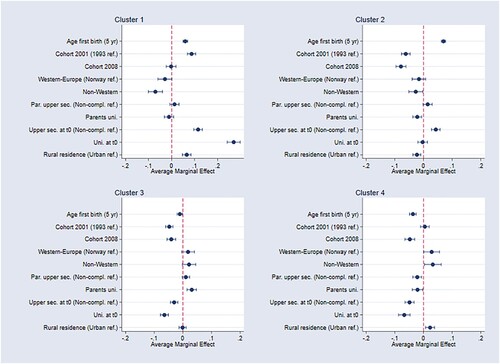
Figure 6. Average marginal effects from selected covariates on the probability of following Clusters 5–7. Note: Age effects are in the regressions interpreted in five-year units. Reference categories for dummy variables are found within brackets.
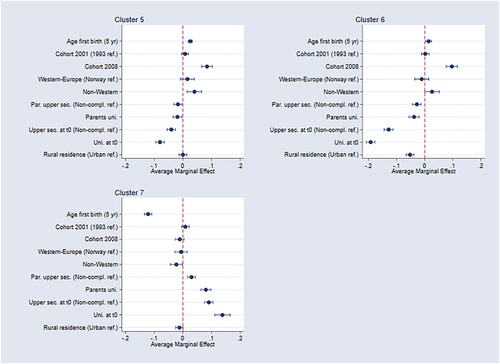
Table 4. Descriptive statistics.
Overall, the population of single mothers is younger and has lower education at the time of giving birth to their first child than the comparable population of non-single mothers (). Within the single mother population, age during first birth varies from 22 to 26 years. In the comparable group of non-single mothers, the average age is 27. Furthermore, there is a very strong underrepresentation of non-Western immigrants among the single mothers. Interestingly, the share with rural residence is higher among the single mothers than in the general population of young mothers. The representation of single mothers is also higher in the 2001-cohort and lower in the 2008-cohort compared to the general population. Overall, earnings and work activity are lower among the single mothers than in the general population.
Cluster 1, characterized by strong labour market integration and very rapid family re-establishment, has some very distinct demographic and socioeconomic characteristics. shows that most people in this cluster became single parents at a rather mature age averaging almost 26 years of age, after completing upper secondary or higher education. Furthermore, Norwegian-born people are over-represented compared to the other clusters as well as the general population of non-single mothers, and there is a substantial share whose parents completed upper secondary education. Those on this trajectory have the highest earnings of all the trajectory types, averaging 264 194 NOK at their 2015-value. In comparison, the average income for the most disadvantaged trajectory type (Cluster 6) is well below 120 000 NOK. Interestingly, the 2001 cohort is very dominant at almost 60%, while the comparable size in the general population is 33%. In this context, it is relevant that this in-between cohort was the only one of the three that did not experience an economic slump over the observation period. , depicting the AME from multinomial logistic regressions, corroborates the results from the descriptive statistics and emphasizes the significance of higher education for this trajectory.
Cluster 2 is also characterized by strong labour market integration, but family establishment is slow. Interestingly, this cluster shows a sharp decrease in size over the three cohorts. Thus, the 2008 cohort is only slightly more than a third of the size of the 1993 cohort (15% versus 42%). Like to Cluster 1, average age at the birth of the first child is high at 26 years, and the majority of these mothers have completed upper secondary or higher education. At almost 90%, the majority population dominates this cluster as well. Those on this trajectory have the second highest average earnings and the highest share of full-time work of all the trajectory types at 258 071 NOK. The AME plot () reveals that higher education does not significantly increase the probability of following this trajectory type.
Cluster 3 is characterized by a long period of alternative financial support and slow or no family re-establishment. Such trajectories are more prominent for the 1993 cohort than for the 2001 or 2008 cohort. Below, this finding is discussed in light of significant cuts to the transitional benefit in 1998. The proportion of mothers of non-Norwegian origin is approximately 15% and higher in Cluster 3 than in Cluster 1 or 2. Furthermore, a majority of 56% in this cluster had their first child before completing upper secondary education. This is also corroborated by AME in . Descriptive statistics depicting work activity and income over the period show that part-time work and moderate earnings are common in this cluster.
Cluster 4, placed in the group of clusters with weak labour market integration, is characterized by alternative income sources, rapid family establishment and multiple additional children. shows that the average age at the birth of the first child is relatively young at 23 years. Relative to cohort size, this trajectory type is least common for the 2008 cohort. Similar to Cluster 3, it can probably be seen in relation to the 1999 cuts in the transitional allowance for single parents. Compared to the other clusters, mothers of non-Norwegian origin are slightly over-represented, and non-completion of upper secondary education is common for mothers on this trajectory. The AME plot () confirms that upper secondary or higher education reduces the probability of following this trajectory by respectively 5 and 7%, but not that immigrant status makes any substantial difference. According to the descriptive statistics in , the share of full-time work and average earnings is also very low.
Cluster 5 shares several characteristics with Cluster 4 but is dominated by health-related benefits and unemployment instead of alternative sources of financial support. In terms of its relative size, the 2008 cohort is over-represented on this trajectory. The regression results confirm this, showing an increased probability of 9% following such a trajectory for the 2008 cohort compared to the 1993 cohort. There is a strong representation of non-Norwegians, particularly non-Western immigrants. However, these effects are less pronounced in the AME plot (), where non-Western immigrants have a 4% higher probability than the majority population of following this trajectory type. shows that almost 63% of those who follow it had not completed upper secondary education before having their first child. The education effects are confirmed by the regression results, showing that education at the upper secondary or higher decrease the probability of following this trajectory type by respectively 4 and 8%. Not surprisingly, the shares of full-time work and income are low.
In Cluster 6, we find single mothers who are predominantly unemployed or receiving health-related benefits throughout the observation period. Few re-establish families with a new partner and new children, and those who do postpone it until the end of the period. As in Cluster 5, the 2008 cohort is over-represented compared to the other trajectory types. Furthermore, the number of non-Western immigrants following such trajectories is high, and the proportion with incomplete upper secondary school is exceptionally high at almost 66%. Interestingly, and after we controlled for other characteristics, the effect of country background is not very pronounced in the AME plots (). Nonetheless, the AME plot confirms that leaving school early is an exceptionally high-risk factor for this trajectory type. Thus, having achieved higher education before becoming a mother, lower the probability of following this trajectory type by 20%. Moreover, low socioeconomic background, indicated by parental education, levels seem to increase the probability of following this trajectory type. A high proportion (82%) of those in this trajectory live in urban areas. Income and share of full-time work are among the lowest of the seven trajectory types.
Finally, Cluster 7 is characterized by long periods of education followed by work and subsequent family establishment. Age of first birth is less than 23 years, and the lowest among the seven trajectory types. The multivariable regression analyzes confirm the effect of age, showing that for every five-year increase in age, the trajectory-probability decrease by 12%. Parental education is the highest among the seven trajectory types, and its effect is also corroborated by the regression analysis. Completion of upper secondary school or higher education increases the probability of falling into this cluster quite substantially. Most likely, many of its followers gave birth to their first child as they were undergoing higher education. A large proportion of this group was still undergoing education towards the end of the observation period. This might also explain why income and share of full-time work are low for this trajectory type.
Interestingly, the overall effect of immigrant status seems generally to weaken when we control for other background characteristics in the multivariable regression analyzes. Thus, it is only in the strong labour market integration of Cluster 2 and the weak labour market integration of Cluster 5 where there are significant but not very strong differences from the majority population. At a general level, educational status at the time of becoming a mother, age, and cohort seem to be most strongly related to trajectory type.
Discussion
In this article, we have analyzed the family, work and welfare trajectories of Norwegian single mothers who were unpartnered while they had their first child in 1993, 2001 and 2008. We wanted to explore how this life event influenced the spheres of family and work/welfare and the connections between the spheres. Our aim was to provide new knowledge on how unpartnered single motherhood changes over time and explore the relationship between timing in the life course, historical changes, family and work/welfare trajectories.
The common occurrence of rapid family re-establishment and the birth of additional children highlights the dynamic qualities of single motherhood status. This is an important reminder and a caution against treating single motherhood as a permanent status.
The results corroborate previous findings of great heterogeneity within the category, concerning both trajectory types and sociodemographic characteristics (Bernardi et al., Citation2019; Zagel, Citation2013). Thus, for all three cohorts, single motherhood is followed by a variety of trajectories, including those that may be termed either successful or problematic. By ‘successful’ we mean trajectories with strong work integration, eventual (re)partnering and additional children. By ‘problematic’ we refer to trajectories with long spells of unemployment, health-related benefits and unstable employment. Overall, work is the most dominant status – and as expected, in the light of previous research, work activity increases over the seven-year timeline. However, many experience unemployment compared with the general unemployment rate. We also find that many were receiving other welfare benefits at the end of the period, given that the study concerned a group of young women (the oldest was 40 years of age). However, because previous research found that single mothers have higher risks of health problems, this may not be surprising.
In the historical period of this study, welfare benefits, the labour market as well as general norms about family formation and practices have changed. The main change in the Norwegian context is the altered policy towards single parents. Over the period from 1990 to 2015, there has been a development whereby Norwegian single mothers with children below the age of three years have become increasingly economically dependent on their success in the labour market. Our data give us the opportunity to contextualize how individual life courses are framed by the welfare state and welfare state reform. Previous research led us to expect that single mothers had increased their paid labour activity without improving their financial situation as a group. Our findings do not confirm a general increase in paid labour over the period. Instead, we find that labour market integration follows economic cycles closely. Thus, the probability of following trajectories with strong labour market integration was highest for those in the 2001 cohort, who experienced an unbroken economic growth in the observation period. This confirms findings of earlier research that economic cycles are important for single mothers.
Interestingly, but not surprising, the welfare state framework has relevance for the life courses of single mothers. There are strong indications that tightening the transitional allowance promoted a displacement from trajectories characterized by alternative sources of financial support (Cluster 4) to trajectories characterized by health-related benefits (Clusters 5 and 6). This could be due to deteriorating health among single mothers, but it could also be interpreted as an indication of the medicalization of social needs where a targeted benefit is replaced by health-related benefits (Wittlund et al., Citation2022). Furthermore, emphasizing the importance of the welfare state framework, long and slow labour market integration with alternative income sources (Cluster 3) was less common after the tightening of the transitional allowance. The opportunities the previous welfare scheme provided for a slower entrance to the labour market with part-time work and moderate earnings were not available for the two more recent cohorts.
The explorative qualities of sequence analysis provide a rich depiction of how events such as family establishment, work, welfare benefits and education interact in a life course perspective. Even so, sequence analysis, in the form presented here, does not provide answers to questions of causality. Thus, answers related to the above-mentioned question of health versus medicalization, will have to be answered utilizing other approaches.
Overall, the analyzes show that the life domains in this study are interconnected. Our correlation measures indicate that the interconnectedness between the family sphere and work is weaker during economic slumps. Thus, work and family careers are more streamlined in good times. Another cohort-specific finding, representing more prolonged development, is the much stronger interdependence between marital status and having additional children for the first cohort compared with the two later ones. In this context, it is pertinent to ask whether this uncoupling could be seen as the result of a change in general normative expectations towards marriage and childbirth. That mothers make independent decisions about (re)partnering/marriage/cohabitation and having additional children is not surprising, as different family forms have received greater acceptance in recent decades.
In accordance with the life-course perspective, the timing of motherhood is strongly related to both education and labour market trajectories as well as family establishment trajectories. By comparing women who entered single motherhood when they were between 17 and 19 years old with the 26–28 age group, we found that interdependence between the life domains of work and marital status was higher among the older single mothers than among the younger women. This is not surprising, as older mothers are probably more established regarding education/employment and decided to have a child while unpartnered later in the life course. The connection between establishing a family with a new partner and having more children was strong for both young and older mothers, but was strongest for the youngest mothers.
Although coming from a socio-democratic and extensive welfare state, our findings give some important insights of relevance for policymakers also in other countries. Unpacking the category of single parents has shown this to be a heterogenous group in a dynamic life phase, which is followed by a variety of trajectories regarding having more children, (re)partnering, education, work and welfare support. However, while most do well, our results also confirm that this is a risky life event, where unfavourable labour market fluctuations increase the risk of individuals ending up on problematic trajectories, and welfare state schemes are important for providing opportunities and reducing disadvantages. That this is so in the Norwegian context, which has been among the most favourable welfare regimes and economies in Europe, shows the danger in considering the challenges of unpartnered single mothers as something of the past. Giving young mothers the opportunity and support to continue their education seems of particular importance.
Disclosure statement
No potential conflict of interest was reported by the author(s).
Additional information
Notes on contributors
Thomas Lorentzen
Thomas Lorentzen is professor at the Department of Sociology at the University of Bergen, Norway. He works with analyses of education, labour market outcomes and welfare receipt and teaches statistical methods. Lorentzen is particularly interested in longitudinal data analysis utilising administrative data. His research interests have over the last years been focused on the transition between youth and adulthood.
Liv Johanne Syltevik
Liv Johanne Syltevik is professor at the Department of Sociology at the University of Bergen, Norway. Her research has focused on family-practices, single motherhood, welfare bureaucracy and welfare policy.
Notes
1 In this article, we discuss the situation of mothers. Most single parents are mothers, and comparisons of single mothers and fathers find that single fathers differ according to economic situation, relationship with the other parent, and support from networks, in Norway as well as internationally (Bernardi et al., Citation2018; Kjeldstad, Citation2000). Being born to a single mother without a partner affects about 1 of 10 children in Norway. Seven per cent of all Norwegian children aged 0–1 year live only with their mothers, while 3% live with their mother and a stepparent. Only 0.3% of newborn children 0–1 year of age live only with their fathers (SSB, Citation2021).
2 Attempts to refine the work categories to distinguish between status or income groups did not provide distinct trajectory types when running the optimal matching and clustering procedure.
References
- Abbott, A., & Tsay, A. (2000). Sequence analysis and optimal matching methods in sociology: Review and prospect. Sociological Methods & Research, 29(1), 3–33. https://doi.org/10.1177/0049124100029001001
- Bernardi, L., Huinink, J., & Settersten, R. A. Jr. (2019). The life course cube: A tool for studying lives. Advances in Life Course Research, 41 (September), 100258. https://doi.org/10.1016/j.alcr.2018.11.004
- Bernardi, L., Mortelmans, D., & Larenza, O. (2018). Changing single parents, changing life courses. In L. Bernardi, & D. Mortelmans (Eds.), Single parenthood in the life course (pp. 1–26). Springer Nature.
- Bjørnstad, A. L. (2009). Enslige forsørgere og overgang til arbeid [Single parents and transition to work]. Arbeid og Velferd, 3(4), 56–61.
- Brady, D., & Burroway, R. (2012). Targeting universalism and single-mother poverty: A multilevel analysis across 18 affluent democracies. Demography, 49(2), 719–746. https://doi.org/10.1007/s13524-012-0094-z
- Duncan, S., & Edvards, R. (1999). Single mothers, paid work and gendered moral rationalities. MacMillan Press.
- Elder, G., Johnson, M. K., & Crosnoe, R. (2003). The emergence and development of life course theory. In J. T. Mortimer, & M. J. Shanahan (Eds.), Handbook of the life course (pp. 3–22). Springer.
- Fasang, A. E., & Aisenbrey, S. (2021). Uncovering social stratification: Intersectional inequalities in work and family life courses by gender and race. Social Forces, 101(2), 575–605. https://doi.org/10.1093/sf/soab151
- Fjær, S., & Syltevik, L. J. (2002). Omsorg, tid og penger for likestillingens frontløpere [Care, time and money for the frontrunners of gender equality]. Report 2. Uni Rokkan Centre.
- Gabadinho, A., Ritschard, G., Müller, N. S., & Studer, M. (2011). Analyzing and visualizing state sequences in R with TraMineR. Journal of Statistical Software, 40(4), 1–37. https://doi.org/10.18637/jss.v040.i04
- Gauthier, J. A., Widmer, E. D., Bucher, P., & Notredame, C. (2010). Multichannel sequence analysis applied to social science data. Sociological Methodology, 40(1), 1–38. https://doi.org/10.1111/j.1467-9531.2010.01227.x
- Halrynjo, S., & Teigen, M. (Eds.). (2016). Ulik likestilling i arbeidslivet [Unequal equality in the labour market]. Gyldendal Norsk Forlag.
- Kiernan, K., Land, H., & Lewis, J. (1998). Single motherhood in the twentieth century Britain: From footnote to front page. Clarendon Press.
- Kjeldstad, R. (1998). Enslige forsørgere: Forsørgelse og levekår før og etter overgang til en ny livsfase [Single parents: Provision and living conditions before and after transition to a new life phase]. Report 100 Social and Economic Studies. Statistics Norway.
- Kjeldstad, R. (2000). Employment strategy policies and single parenthood: The case of Norway. Social Politics: International Studies in Gender, State & Society, 7(3), 343–371. https://doi.org/10.1093/sp/7.3.343
- Kjeldstad, R., & Rønsen, M. (2004). Welfare rules, business cycles, and employment dynamics among single parents in Norway. Feminist Economics, 10(2), 61–89. https://doi.org/10.1080/1354570042000217720
- Klett-Davies, M. (2007). Going it asingle? Single motherhood in late modernity. Ashgate.
- Kühn, M. (2018). Changes in single mothers’ health: A longitudinal analysis. In L. Bernardi, & D. Mortelmans (Eds.), Single parenthood in the life course (pp. 323–338). Springer Nature.
- Letablier, M.-T., & Wall, K. (2018). Changing single parenthood patterns: New challenges for policy and research. In L. Bernardi, & D. Mortelmans (Eds.), Single parenthood in the life course (pp. 29–52). Springer Nature.
- Lewis, J. (1997). Single mothers: The British case. In J. Lewis (Ed.), Single mothers in European welfare regimens: Shifting policy logics (pp. 50–75). Jessica Kingsley Publishers.
- Løken, K. V., Lommerud, K. E., & Reiso, K. H. (2018). Single mothers and their children: Evaluating a work-encouraging welfare reform. Journal of Public Economics, 167, 1–20. https://doi.org/10.1016/j.jpubeco.2018.09.003
- Mayer, K. U. (2004). Whose lives? How history, societies, and institutions define and shape life courses. Research in Human Development, 1(3), 161–187. https://doi.org/10.1207/s15427617rhd0103_3
- Mogstad, M., & Pronzato, C. (2012). Are single mothers responsive to policy changes? Evidence from a workfare reform in a generous welfare state. Scandinavian Journal of Economics, 114(4), 1129–1159. https://doi.org/10.1111/j.1467-9442.2012.01722.x
- Nieuwenhuis, R., & Maldonado, L. C. (2018). The triple bind of single-parent families: Resources, employment and policies. In R. Nieuwenhuis, & L. C. Maldonado (Eds.), The triple bind of single-parent families: Resources, employment and policies to improve wellbeing (pp. 1–28). Policy Press.
- Øyen, E. (1966). Ugifte mødre [Unwed mothers]. Universitetsforlaget.
- Piccarreta, R. (2017). Joint sequence analysis: Association and clustering. Sociological Methods & Research, 46(2), 252–287. https://doi.org/10.1177/0049124115591013
- Pollock, G. (2007). Holistic trajectories: A study of combined employment, housing and family careers by using multiple-sequence analysis. Journal of the Royal Statistical Society, Series A, 170(1), 167–183. https://doi.org/10.1111/j.1467-985X.2006.00450.x
- Reiso, K. H. (2014). Young employed single mothers and their children. PhD thesis, Norwegian School of Economics (NHH), Bergen, Norway.
- Skevik, A. (2006b). Working their way out of poverty? Single mothers in policies and labour markets. In J. Bradshaw, & A. Hatland (Eds.), Social policy, employment and family change in comparative perspective (pp. 221–236). Edward Elgar.
- Skevik, A. G. (2006a). Single motherhood in the Nordic countries: Sole providers in dual-breadwinner regimes. In A. L. Ellingsæter, & A. Leira (Eds.), Politicising parenthood in scandinavia: Gender relations in welfare states (pp. 241–265). Policy Press.
- Stabel, C. (2017). Barnehagedekning før og nå [Kindergarten coverage]. Statistics Norway.
- Statistics Norway (SSB). (2021). Barn etter foreldrenes samlivsform og alder [Children and parents partner status and Age]. Statistics Norway.
- Struffolino, E., & Mortelmans, D. (2018). Single mothers in Belgium: Labor force attachment and risk factors. In L. Bernardi, & D. Mortelmans (Eds.), Single parenthood in the life course (pp. 260–282). Springer Nature.
- Studer, M. (2013). Weighted cluster library manual: a practical guide to creating typologies of trajectories in the social sciences with R. LIVES Working Paper, 24.
- Studer, M., & Ritschard, G. (2014). A comparative review of sequence dissimilarity measures. LIVES Working Paper, 33.
- Syltevik, L. J. (2006). Taking control of one’s own life? Norwegian single mothers experiencing the new employment strategy. Community, Work & Family, 9(1), 75–94. https://doi.org/10.1080/13668800500421036
- Wittlund, S., Mykletun, A., & Lorentzen, T. (2022). Disability pension dynamics in early adulthood: A two-decade longitudinal study of educational, work and welfare-state trajectories in Norway. SSM Population Health, 17 (March), 101062. https://doi.org/10.1016/j.ssmph.2022.101062
- Zagel, H. (2013). Are all single mothers the same? Evidence from British and West German women’s employment trajectories. European Sociological Review, 30(1), 49–63. https://doi.org/10.1093/esr/jct021
- Zinn, M. B., Eitzen, D. S., & Wells, B. (2011). Diversity in families (9th ed.). Allyn & Bacon.
Appendix
Table A1. Multinoimial regression, average marginal effects.

